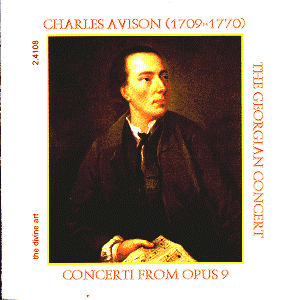This group are made up of six players
(or is it seven?) and they produce a rather unusual intimate sound.
This works really well in the slow movements but may lack bite in the
quick movements. The playing is extremely good and the recording presents
no problems.
Charles Avison was born in Newcastle
in 1709 and was the city cathedralís organist from 1736 until his death
in 1770. He was a highly intellectual man and organised subscription
concerts. He was a gifted writer on music and wrote a treatise on expression
in music. The Georgian Consort seem to have this concept in mind.
The set of twelve concerti grossi appeared
in 1766 and were unusual in that they were written in four parts and
so can be played in more than one way, as string quartets, for example.
Most concerti grossi had seven parts. The keyboard part was written
so that the concerti could be played as harpsichord solos.
The Concerto Grosso is mainly associated
with Italy and Europe. There cannot be many British born composers of
Avisonís time who wrote in this form. That adds to the interest. I do
not have any score of these concerti but what strikes me is the lack
of ornate ornamentation that infuses other composersí concerti grossi.
The eighth concerto has a very telling
opening andante cantabile, a siciliana, and will leave listeners guessing.
But you buy the disc and be your own detective. The third movement,
an adagio, is here given to the keyboard. Three of the concerti end
with an unusual finale each time marked aria which, again, may show
Avisonís preoccupation with expressive music or the influence of cathedral
and church music which was probably mostly sedate in his time.
The predominance of dotted rhythms pervades
most of the quick movements but I would have liked more energy in the
performances. The elegance is great but there needs to be more spirit
in the faster music, I feel.
The photo of the consort has a missing
person but it is good to see such faithful servants of music like Duncan
Druce still giving of his talent, experience and dedication.
David Wright


